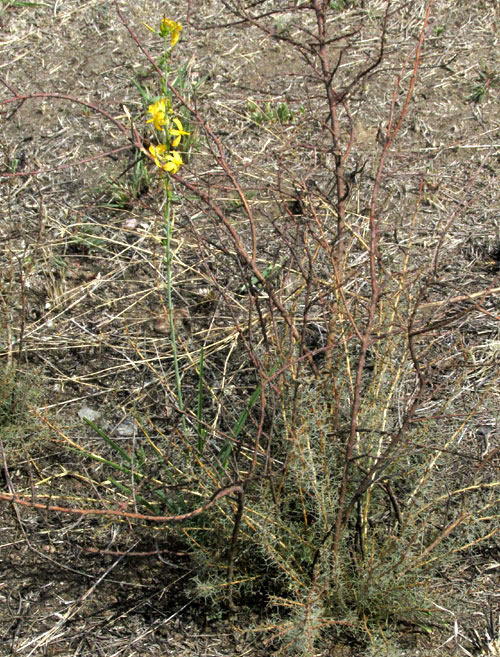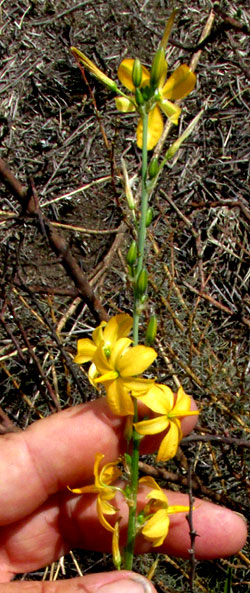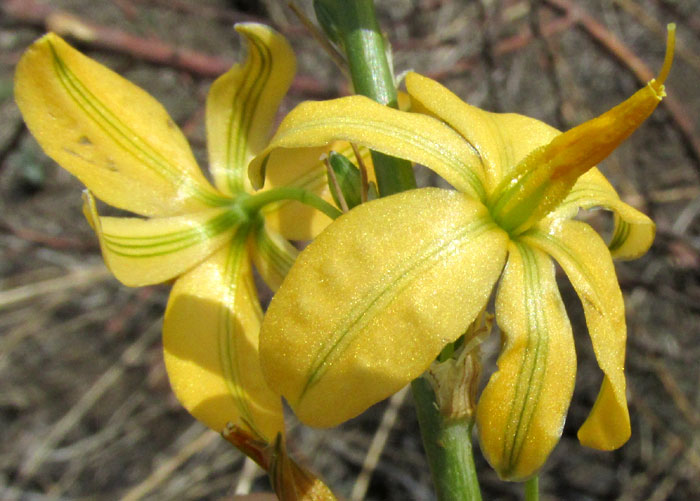Excerpts from Jim Conrad's
Naturalist Newsletter
entry dated July 15, 2022, issued from near Tequisquiapan, elevation about 1,900m (6200 ft), N20.565°, W99.890°, Querétaro state, MÉXICO
CRAGLILY


On a grossly overgrazed, yearly burned, eroding, rocky slope of dirt developed from hard-compacted sediment from nearby hills composed of igneous rhyolite rock, the above tender-herbaceous wildflower had found refuge amid a defensive tangle of spiny, wiry bushes. At the right, my hand steadies the slender inflorescence otherwise gyrating in the wind.
I thought that such a pretty, distinctive wildflower would be easy to identify, but it turned out to be a hard one. Features important to notice at the right include the fact that the flowers' stems, the pedicels, aren't particularly long, and the blossoms don't especially "nod," or direct their faces noticeably downward. These features aren't satisfyingly precise, but that's typical with this genus.

The above picture, though, shows a very important and definite feature, which is that the six stamens' anthers are connected by their margins to form a cylinder around the long, slender style seen bending upwards at the picture's upper, right. Several species of this kind of wildflower have loosely arranged stamens with anthers held wide apart.
The above picture also shows back and front views of the flower. The back view on the left shows that there's not much difference between sepals and petals, so the parts are called "tepals." On the right, the greenish ovary can be seen caged in by the stamens' filaments. Thus here we have a "superior ovary," meaning that the tepals and anthers arise at the base of the ovary, not at its top. That fact disqualifies many species, such as those in the iris family, with "inferior ovaries." In the old days our superior ovary would have clearly indicated that our flower belongs to the "Lily Family," but of course nowadays it's an ambiguous situation.

The slender leaves shown above emerging from the ground also are important to notice. Mainly, they're rather slender, but not conspicuously so.
No floras are available dealing with Mexican species that once were included in the Lily Family. In the end I had to do an image search for Mexican wildflowers with yellow flowers with such nose-like clusters of stamens issuing from the blossoms' centers. It's the genus Echeandia, comprising about 80 species occurring from the arid US southwestern border with Mexico south to northern Argentina and southern Peru. The ones barely making it north into the US are known as craglilies; for example there's the Texas Craglily.
The 2021 work by Juan Pablo Ortiz-Brunel and others, entitled "Biogeographic analysis of the American genus Echeandia" -- notice that they assign our plant to the Asparagus Family, the Asparagaceae, and that seems to be the latest opinion -- enabled the listing of all craglily species occurring here in Mexico's Querétaro state. There were eight of them, of which some were easily rejected because pictures of their flowers showed spreading stamens whose anthers were not joined at their edges. Others bore conspicuously nodding blossoms, one had white tepals, and others had wider or narrower leaves. That left two or three candidates which couldn't be distinguished with Internet pictures.
Finally a 1995 treatment of the genus Echeandia turned up in the Flora of Veracruz, hidden as a member of the family Anthericaceae, which nowadays is lumped into the Asparagus Family. The technical key there led directly to the main suspect on my list of craglilies possibly occurring in Querétaro, which was ECHEANDIA MEXICANA, and Internet pictures seemed to agree. In English the species should be called the Mexican Craglily, but no one seems to be using that name.
The above-mentioned "Biogeographic analysis of the American genus Echeandia" describes Echeandia mexicana as endemic just to Mexico, found from about Guanajuato and Querétaro south to Oaxaca, in both the Eastern and Western Sierra Madres.
Going through the identification process gives the impression that craglilies are a fast-evolving group of plants, often with blurred species boundaries, and the literature suggests why this might be so. At the Red de Herbarios del Noroeste de México website I read that most species fall into one of three groups: slender plants with narrow leaves and narrow capsular fruits; those with narrow leaves and wide fruits; and those with wide leaves and wide fruits. In terms of the number of sets of chromosomes, the first group contains normal diploid species (with two sets of chromosomes; humans are diploid), the second group are hexaploids (six sets), and the third are octoploids (eight sets).
The study "Biogeographic analysis of the American genus Echeandia" finds the highest concentration of Mexican craglily species in the Transmexican Volcanic Zone cutting east/west across central Mexico, where in geological time there's been much shifting of tectonic plates accompanied by volcanic activity. One visualizes the fast-evolving craglily genus pulling all kinds of genetic tricks to adapt to a vast-evolving landscape.
And in this rush it's not too concerned about making its species nicely fit into our human preconceptions.